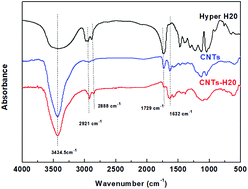Investigation on cure kinetics of epoxy resin containing carbon nanotubes modified with hyper-branched polyester
Abstract
The cure kinetics of epoxy resin cured by diethyltoluene diamine (D-EP), D-EP/multi-walled carbon nanotube (D-EP/CNT) composites and D-EP/hyper branched polyester functionalized CNTs (D-EP/CNTs-H20) were investigated by non-isothermal differential scanning calorimetry (DSC). Results revealed that the presence of CNTs shifted the cure temperature to a lower temperature and accelerated the curing of D-EP, and the addition of CNTs-H20 exhibited a stronger effect in accelerating the cure of D-EP. Activation energies were calculated based on the Kissinger approach and Ozawa approach respectively. Lowered activation energy was observed after the addition of CNTs or CNTs-H20 at low degrees of cure, indicating that the CNTs had a large effect on the curing reaction. The presence of CNTs facilitated the curing reaction, especially the initial epoxyamine reaction. Moreover, CNTs-H20 exhibited better performance. The autocatalytic model was used to describe the cure kinetics phenomena of the studied systems. When CNTs or CNTs-H20 were added, the Sesták–Berggren model still can describe the cure kinetics of the D-EP composites because the results, calculated by the model, agreed with the experimental data well. Moreover, the kinetics parameters as well as the equation describing the cure process were proposed.



 Please wait while we load your content...
Please wait while we load your content...